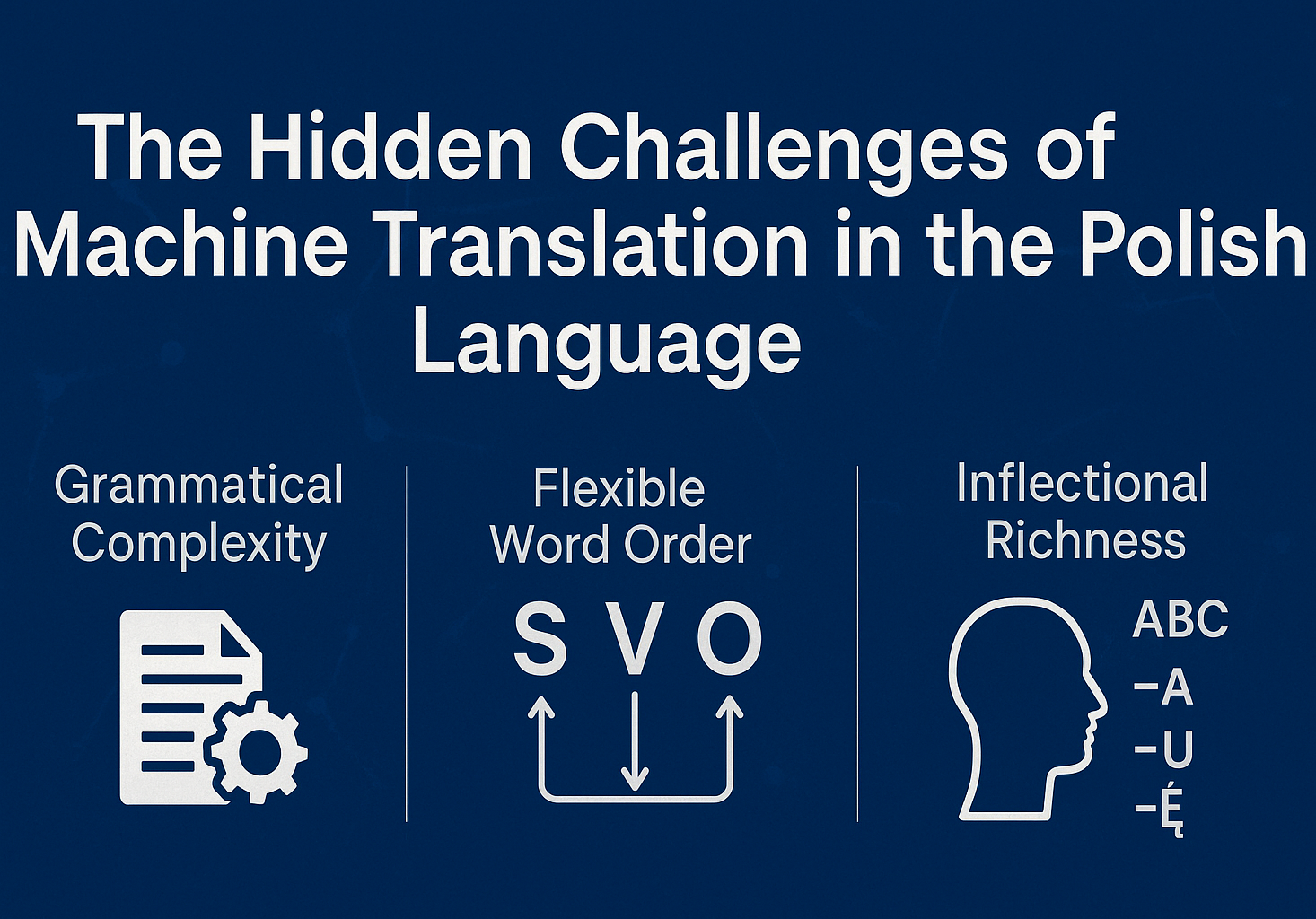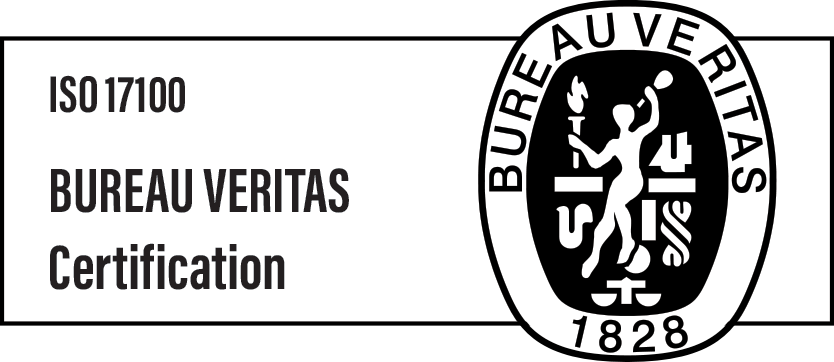The hidden challenges of machine translation in the Polish language

Beyond the algorithm
Machine translation (MT) has revolutionized the way we communicate across borders, offering speed, scalability and convenience at an unprecedented scale. With just a few clicks, we can transform product descriptions, manuals or emails into dozens of languages, making MT an indispensable tool for global business and everyday interactions alike.
But while these systems work remarkably well for some languages, others reveal the limits of algorithmic fluency. Polish is one such language. Known for its grammatical depth, flexible sentence structures and rich inflectional system, Polish poses a unique set of challenges that often leave even the most advanced MT engines struggling to keep up.
What makes Polish so difficult for machines to handle? In this article, we’ll go behind the surface of translation errors to explore the hidden linguistic complexities that trip up AI models, namely: intricate grammar rules, variable word order and a staggering number of inflected word forms. By examining these issues in detail, we reveal why human post-editing remains essential for maintaining translation quality and how machine translation in Polish must be approached with special care.
Grammatical complexity: when rules meet exceptions
At the heart of Polish lies a deeply intricate grammatical system – one that demands precision, contextual awareness and a nuanced understanding of how different parts of speech interact. For machine translation engines, which primarily rely on statistical patterns or learned associations, this complexity creates a major stumbling block.
Polish grammar features strict rules around agreement between nouns, adjectives and verbs, governed by case, number and gender. With seven grammatical cases and three genders, a single noun might appear in numerous forms depending on its role in the sentence. Add to that verbs that shift aspect and tense in elaborate ways, and the potential for error multiplies quickly.
Consider the difference between “ładny dom” (a nice house – nominative) and “ładnego domu” (of a nice house – genitive). To an untrained MT system, these forms may seem interchangeable or contextually irrelevant, but in Polish, they signal entirely different grammatical functions. Without a clear grasp of these distinctions, MT engines often produce translations with misaligned subjects, mismatched adjectives or incorrect verb conjugations – particularly in longer, more complex sentences.
Furthermore, Polish sentences often involve subordinate clauses, relative pronouns and reflexive verbs – all of which require context-sensitive translation choices. Machines that treat language as a linear sequence of tokens are likely to misjudge dependencies between distant words, leading to ungrammatical or awkward constructions.
In short, Polish grammar isn’t just complicated, it’s structurally layered, and it demands a translator (or post-editor) who can interpret both the rules and the intent behind them. Machines can provide a foundation, but only human insight can ensure the result is grammatically sound and naturally fluent.

Grammatical complexity: when rules meet exceptions
Flexible word order: not all sentences are linear
Unlike English, which relies heavily on a fixed Subject–Verb–Object (SVO) word order to convey meaning, Polish allows for a much freer sentence structure. Thanks to its rich system of inflection, the grammatical function of a word is often clear regardless of its position in the sentence. This flexibility gives Polish speakers the freedom to emphasize tone, style or rhythm simply by rearranging word order.
For machine translation systems, however, this freedom can be deeply confusing.
Consider the sentence:
- “Książkę przeczytała Anna” (The book was read by Anna)
- versus: “Anna przeczytała książkę” (Anna read the book)
- or even: “Przeczytała książkę Anna” (Read the book, Anna did)
All are grammatically valid in Polish, yet each carries a slightly different emphasis or narrative flow. To an MT system trained primarily on languages with fixed structures, these variations can cause misinterpretation of roles, mistaking subjects for objects, misaligning verbs or creating unnatural sentence constructions in the target language.
Moreover, when translating from English into Polish, machines may rigidly preserve word order, resulting in translations that are technically understandable but sound robotic or contextually off to native speakers. On the flip side, when translating from Polish to English, MT may fail to correctly identify the sentence’s true subject or focus, leading to inaccuracies in meaning.
The flexibility of Polish word order is a linguistic asset for human expression, but for machines, it’s a minefield. To navigate it successfully, translation systems must be not only syntactically aware but semantically intelligent, recognizing emphasis, hierarchy and intent – something that currently only human post-editors can consistently achieve.

Flexible word order: not all sentences are linear
Inflectional richness: one word, dozens of faces
One of the defining characteristics of the Polish language is its extraordinary degree of inflection. Polish is a highly inflected language, meaning that words change their form depending on their grammatical role, such as case, gender, number, tense, aspect and more.
A single noun in Polish can take on at least 14 different forms (7 cases × 2 numbers), and when combined with adjective agreement, verb conjugation and possessive forms, the total number of possible variants multiplies exponentially. Even simple sentences can involve dense morphological transformations, where a word’s appearance dramatically shifts to signal meaning.
Take the noun “kot” (cat). It transforms into:
- kota (genitive/accusative),
- kotem (instrumental),
- kocie (locative),
- kociego, kociego, kociemu… and more – depending on context and grammar.
This inflectional complexity creates serious challenges for MT systems:
- Word-sense disambiguation becomes harder, especially in sentences where grammatical cues are subtle.
- Machines often default to base or frequent forms, leading to awkward or grammatically incorrect outputs.
- Errors compound when multiple inflected words must agree (e.g., adjectives with nouns, verbs with subjects).
Moreover, inflection affects not only nouns and verbs, but also adjectives, numerals, pronouns and even some prepositions. This makes rule-based parsing inefficient and often inaccurate without deep morphological analysis and contextual awareness.
Even with modern neural architectures, machine translation engines are prone to morphological mismatches, especially when the surrounding context is sparse or ambiguous. That’s why, in practice, human linguists are essential in post-editing Polish MT output.

Inflectional richness: one word, dozens of faces
Compound risk: when challenges intersect
Individually, Polish grammar, word order flexibility and inflectional richness each pose significant hurdles for machine translation. But in real-world texts, these challenges rarely appear in isolation. They overlap and amplify each other.
Imagine a sentence that combines:
- A complex grammatical structure with nested clauses
- Non-standard word order for emphasis
- And multiple inflected elements like adjectives, verbs and pronouns
For a human reader, these features may contribute to clarity, expressiveness or rhetorical impact. For a machine, they’re a recipe for confusion and error propagation. The system may misidentify the subject, apply the wrong case, fail to agree on number or gender, or translate idiomatic expressions literally.
Consider a legal or medical document, where precision is paramount. A single misinterpreted word due to incorrect case usage or misplaced clause emphasis could change the entire meaning of a clause. In creative or marketing texts, poor handling of emphasis and stylistic flow can undermine the brand voice or even result in culturally inappropriate messaging.
The compounding effect of these linguistic features illustrates a fundamental limitation of machine translation: it’s not just about processing vocabulary, but understanding language as a layered, context-rich system. And while MT engines are improving with the help of deep learning and training on Polish-specific data, they are still far from mastering this complexity on their own.
This is why human post-editing is not optional – it’s essential. It’s the stage where a skilled linguist not only corrects grammar, but also untangles meaning, restores nuance and ensures the output truly reflects the original intent.

Compound risk: when challenges intersect
Best practices for Polish MT success
While the challenges of translating Polish via machine translation are significant, they’re not insurmountable. With the right tools, processes and human oversight, it’s possible to harness the speed and scalability of MT while maintaining high linguistic quality. Below are key best practices that help mitigate the pitfalls of Polish machine translation:
- Use domain-trained and Polish-optimized MT engines
Generic translation engines often underperform with Polish due to a lack of language-specific training data. Instead, leverage custom-trained models that are fine-tuned on Polish texts in your specific domain. These engines are better equipped to handle complex morphology, industry jargon and context-sensitive usage.
- Integrate custom glossaries and translation memories
Terminology inconsistency is a common issue in Polish MT. To counter this, maintain detailed glossaries of approved terms and integrate them into your MT pipeline. Translation memories (TMs) also ensure that recurring phrases are translated consistently, reducing manual post-editing effort and improving long-term translation quality.
- Always involve human post-editors
No matter how good the machine output, human review is indispensable. Professional linguists not only correct grammatical and stylistic issues but also interpret tone, intent and cultural nuances. For critical content, full post-editing should be the default.
- Avoid MT for highly creative or sensitive content
Creative marketing campaigns, legal contracts or emotionally charged writing often require a level of nuance and judgment that MT cannot provide. In these cases, a human-first approach is more efficient and reliable than trying to fix flawed machine output.
- Treat feedback as fuel for improvement
Use post-editing insights to improve your MT system over time. Corrected translations should feed back into your training data, TM updates and terminology lists, making the system smarter and more Polish-aware with every project.
When applied consistently, these best practices help strike a balance between automation and accuracy, ensuring that machine translation becomes a powerful aid in your multilingual communication efforts.

Best practices for Polish MT success
Why Polish still needs a human touch
As machine translation becomes faster, smarter and more accessible, it’s tempting to imagine a world where language barriers are effortlessly erased by algorithms. But Polish reminds us that language is more than data – it’s structure, culture, nuance and intent. These are areas where machines still fall short, and where human expertise remains irreplaceable.
Polish’s intricate grammar, variable sentence structures and richly inflected vocabulary create a terrain that’s as beautiful as it is demanding. While neural translation engines continue to evolve, they are not yet equipped to fully capture the subtlety required for accurate, high-quality Polish communication.
That’s why the most effective approach isn’t about choosing between machine or human translation, it’s about combining both. With the speed of AI and the sensitivity of skilled linguists, we can navigate the hidden challenges of Polish and turn even its complexity into a competitive advantage.
After all, when the stakes are high and the message matters, there’s no substitute for the human touch.

